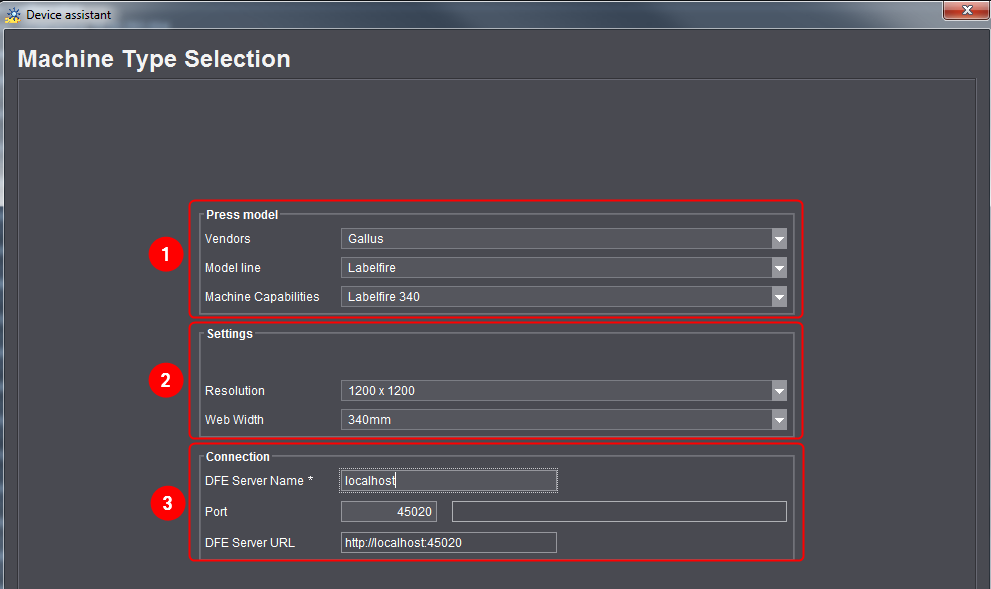
Connecting Digital Presses to the CDM
Like with presses, digital presses are connected through the Device Assistant (CDM). See Device Assistant.
Please also note the following setup information:
•Set up Connection for Labelfire and Primefire
•Set up Connection for Versafire CV/EV, Versafire CP/EP, Linoprint C and Ricoh Totalflow
•Set up Connection for Canon, HP Indigo, Kodak NexPress, Konica Minolta, Ricoh, and Xerox
•Set up Connection for Third-party Machines with JDF/JMF Interface
•Set up Connection for Third-party Machines without JDF/JMF Interface
•Setting up a CTP device for PDF output for small-format platesetters
•Set up Digital Press with Data Terminal Connection
Set up Connection for Labelfire and Primefire

(1) Press model
Choose "Gallus" for Labelfire and the provider "Heidelberg" for Primefire. Model line and Machine Capabilities are set automatically.
(2) Settings
This is where you define your machine settings such as "Resolution".
Enter the server of the renderer/high-performance renderer in "DFE Server Name" (Digital Front End). You can enter either the IP address or the name of the server.
The "Port" is entered automatically. You have to edit it only if you have a different setting on the renderer server.
In "DFE Server URL", the URL is made up of the server name and the port. You do not need to make any changes in this box.
Note: In the case of the Labelfire, you must then set up the LVIS (Linoprint Variable Image System) on the machine. See Configuration of the Labelfire LVIS.
Set up Connection for Versafire CV/EV, Versafire CP/EP, Linoprint C and Ricoh Totalflow
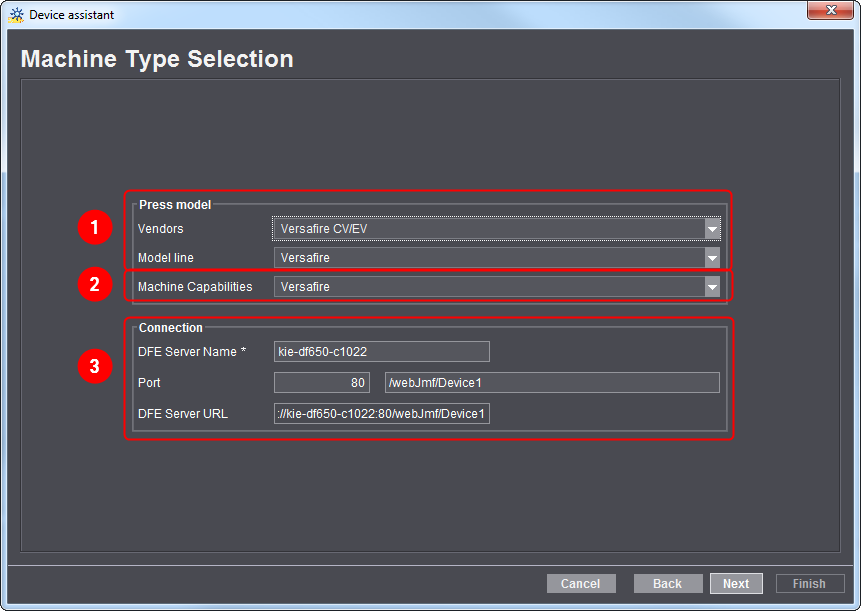
(1) Vendors and Model line
Select the vendor and the series of your machine (Versafire CV/EV, Versafire CP/EP, Linoprint C or Ricoh Totalflow).
Note: You must select "Versafire CP/EP" or "Versafire CV/EV" for connection of a Linoprint CV/CP (predecessor of Versafire CV/CP).
(2) Machine Capabilities
Select the item matching your machine options.
|
Machine |
Machine Capability |
Explanation |
|---|---|---|
|
Versafire CP/EP |
Versafire Plockmatic |
Booklet finisher |
|
Versafire |
For all machines without Plockmatic |
|
|
Linoprint C751 |
Fold_Staple_Interposer_SR5040_Trim_Punch4 |
Multi folder, high capacity stacker, booklet finisher SR5040 with Cover Interposer, front trimmer and 4 hole punching |
|
Fold_Staple_SR5030_Punch4 |
Multi folder FD5010, high capacity stacker SK5020, standard finisher SR5030 with 4 hole punching |
|
|
Interposer_SR5040_Trim_Punch4 |
Booklet finisher SR5040 with Cover Interposer, front trimmer and 4 hole punching |
|
|
SR5030_Punch4_Plockmatic |
Standard finisher SR5030 with 4 hole punching, Plockmatic |
|
|
Staple |
High capacity stacker SK5020 |
|
|
Linoprint C901 |
SR5000_Punch4_Interposer_Plockmatic |
Standard finisher SR5000 with 4 hole punching and Cover Interposer, fully automatic Plockmatic (with page trimmer) |
|
SR5020_Punch4_Interposer_2Staple |
Booklet finisher SR5020 with 4 hole punching and Cover Interposer, two high capacity stackers |
(3) Connection
Enter the server of the digital front end in "DFE Server Name" (Digital Front End). You can enter either the IP address or the name of the server.
The "Port" is entered automatically. You have to edit it only if you have changed it on the DFE server.
Set up Connection for Canon, HP Indigo, Kodak NexPress, Konica Minolta, Ricoh, and Xerox
Press model
Select the manufacturer. Model line and Machine Capabilities are set automatically.
Connection
See (3) Connection.
Set up Connection for Third-party Machines with JDF/JMF Interface
Third-party machines with a JDF/JMF interface can also be connected online. In contrast to other third-party machines, these machines can send feedbacks like printing materials to the Prinect system. Please contact your vendor to find out if your machine has this interface.
To connect the press, select the following settings when setting up the press model:

(1) Press model
Select "Heidelberg-JDF Engine Interface" as vendor. Model line and Machine Capabilities are set automatically.
(2) Connection
Enter the server of the digital front end in "DFE Server Name" (Digital Front End). You can enter either the IP address or the name of the server.
The "Port" is entered automatically. You have to edit it only if you have changed it on the DFE server.
Set up Connection for Third-party Machines without JDF/JMF Interface
All digital presses not yet supported by Heidelberg and have not implemented a JDF/JMF interface (see Supported Digital Presses) can be connected via a generic interface. To connect the press, select the following settings when setting up the press model:
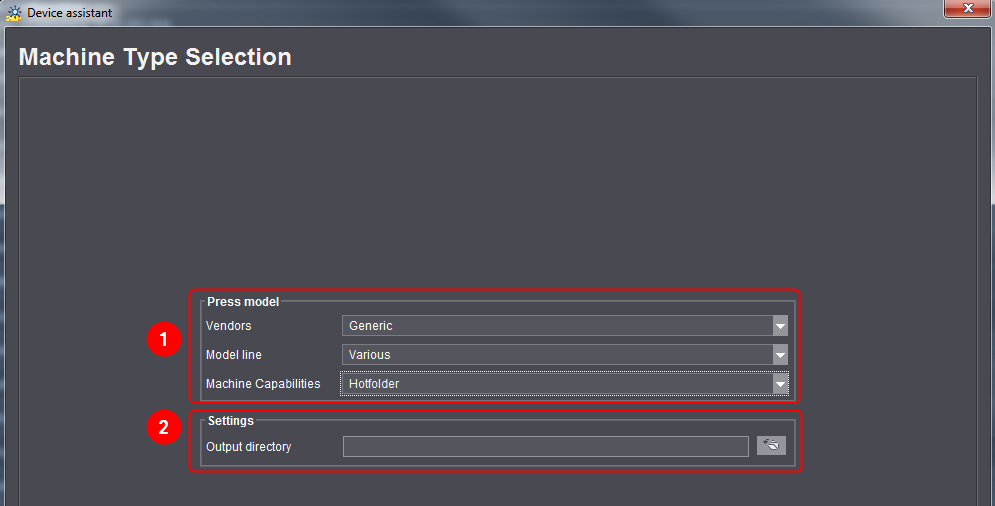
(1) Press model
Select "Generic" as the Vendor. The model line is set automatically.
(2) Output directory
This is where you specify the folder (hotfolder) to which the Prinect Digital Front End will later write the PDF files for the digital press. This folder must be shared.
The output directory is a root directory. In the Prinect workflow, all subdirectories of this directory are treated like "virtual printers" (see Printing Materials and Substrates). As a rule, the names of the subfolders you set up there should match the names of the "virtual printers" you set up on the DFE.
Setting up a CTP device for PDF output for small-format platesetters
Small print shops often have a simple small-format offset workflow in addition to their digital printing workflow. These print shops produce comparably simple products and use simple tools for press sheet generation. In this context, outputting a layout as PDF to the platesetter's RIP is often sufficient.
For this purpose, Heidelberg offers the option of creating a layout in the Digital Front End and outputting it as a PDF. The format is restricted to a maximum size of 656 mm (width) x 530 mm (height).
To output such a PDF, a digital press has to be set up at the CDM. After having made general settings (see "Set up Connection for Labelfire and Primefire", page 1747), make the following settings in the "Machine Type Selection" dialog:
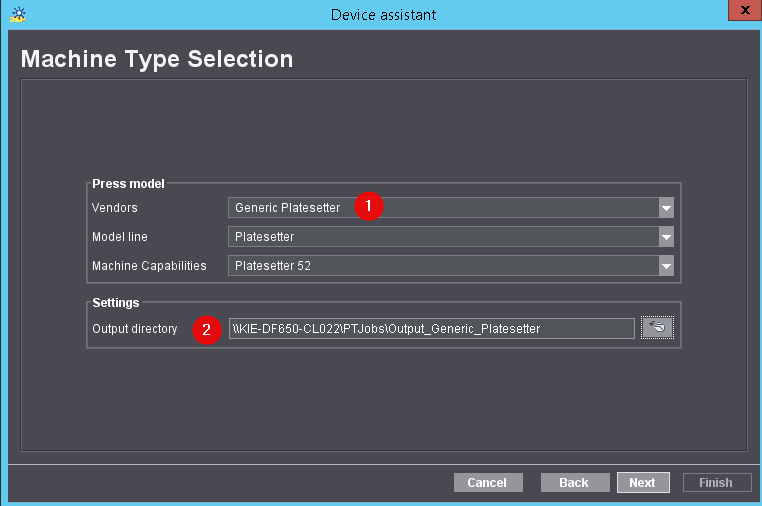
Select "Generic Platesetter" (1) as the vendor. For Output directory (2), select a folder where the PDFs for the RIP are to be written later. The RIP has to have access to this folder as well.
You can then set up a "PagePrint" sequence selectable in the "Digital Printing" step for the new device. Here you can edit the plate format, specify the position of the sheet and place pull lays.
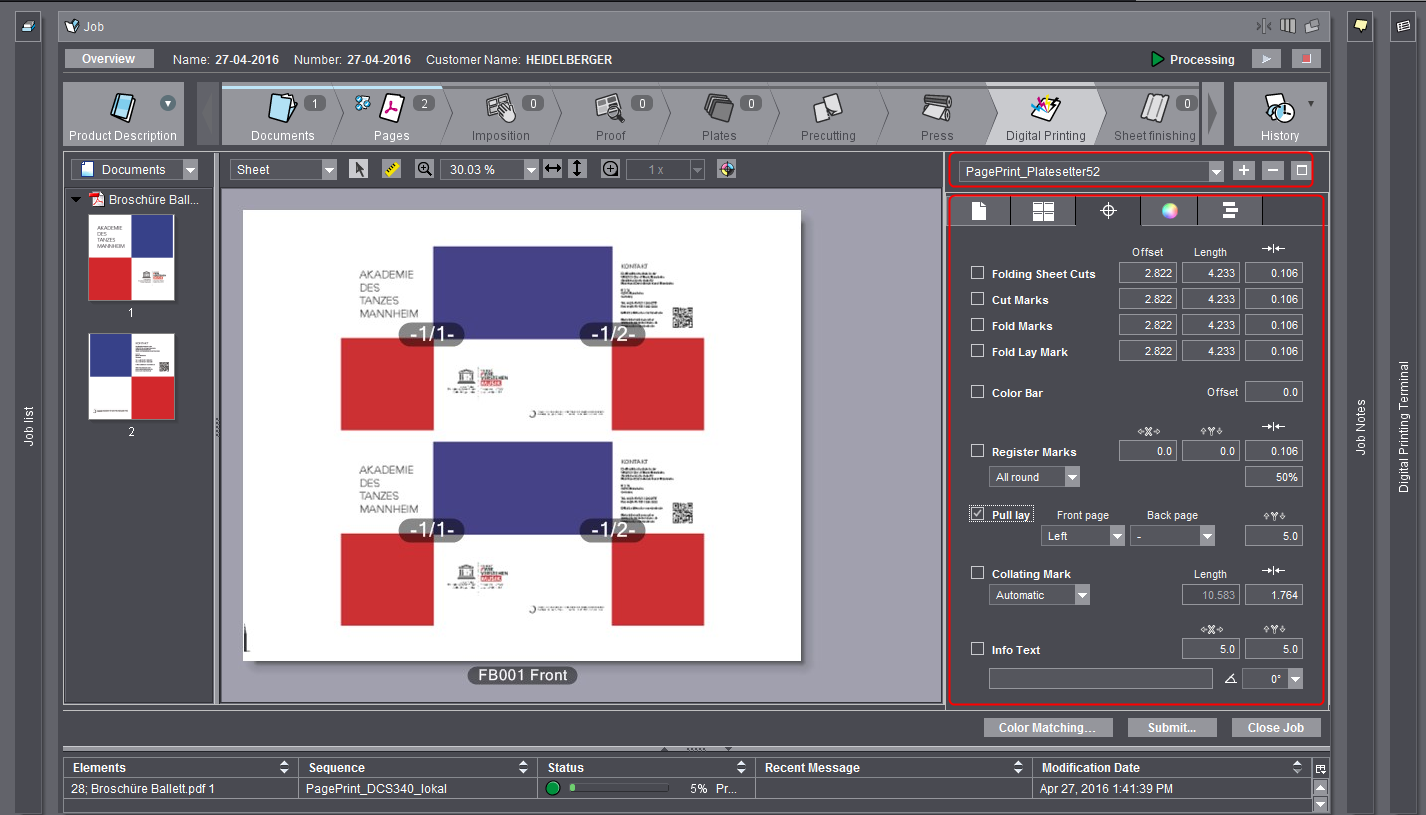
Set up Digital Press with Data Terminal Connection
You can set up a digital press as a Data Terminal device if you need it solely for production data collection.
To do this, select "Data Terminal" as the connection:
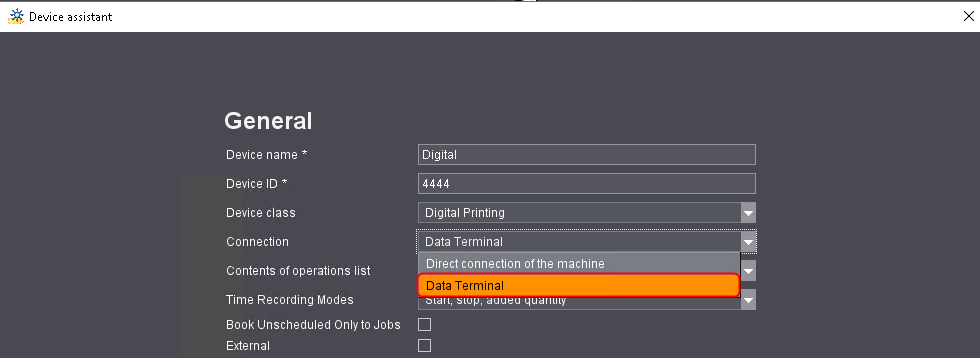
For all other steps, see:
•Device Assistant - "Assigning operation groups" and "Assigning operations"
•Device Assistant - Assigning User Groups
•Device Assistant - Creating Variants